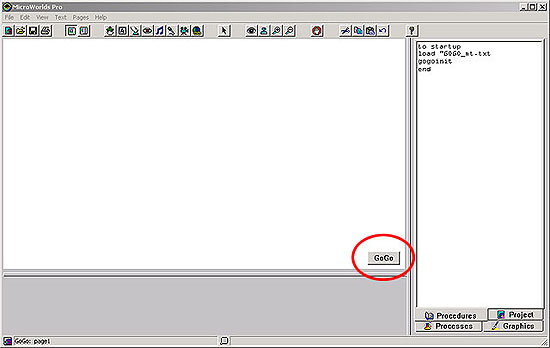|
|||||
|
GoGo board library for Microworlds Logo
| |||||
Setting up the GoGo board You first need to connect the GoGo board to the computer and power it. Please refer to the getting started guide for more information.
|
||
| The GoGo.MW2 Template file Using the Microworlds GoGo library is very simple. The easiest way to get started is to open the template file GoGo.MW2. It is one of the files that comes with the the GoGo library. Figure 1 shows how the screen should look like after you open the GoGo.MW2 file.
Talking to the GoGo board It is important to remember that you must always run a procedure called "GoGo" in order to communicate with the GoGo board. The GoGo template file provides a convenient way of doing this; You simply click on the GoGo button on the lower right corner of your project (circled in figure 1). Once GoGo is pressed, try to read from the sensor port. For example, you can type "show sensor1" in the command center. You should see a number, which is the sensor value of sensor port 1. In the example above sensor1's value is 1023 which is normally what you get when there is not a sensor connected to the port.
Next, try to turn on an output port. You can type in something like "tta on" which will turn on output port A. Type "off" to turn the port off. Here's how it works.
Where to go from here Once you get the board working. You can start working with sensors, motors in your Logo projects. Please read the command reference for a complete explanation of the available commands. You should also visit the project examples page to see what others have used the GoGo board for.
Trouble shooting. If you have problems communicating with the GoGo board, here are a few tips
|

Last updated: 2/21/2003 6:13:38 PM

